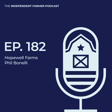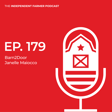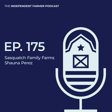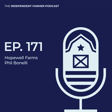Become a Creator today!Start creating today - Share your story with the world!
Start for free
00:00:00
00:00:01

Exclusive Content: Planting for Profit
Price your Produce for consistent revenue that secures a healthy Profit. In this week’s episode, listen to the Audible version or our newest eBook - Planting for Profit.
Download the eBook: https://www.barn2door.com/e-books/planting-for-profit
For more resources, including eBooks, visit https://www.barn2door.com/resources
Transcript
Introduction to the Podcast
00:00:10
Speaker
Hello and welcome to the Independent Farmer Podcast, the go-to podcast for do-it-yourself farmers who are taking control of their own business, skipping the middleman, and selling direct to local consumer and wholesale buyers. This podcast is hosted by Barn to Door, the number one business tool for independent farmers to manage their business, promote their brand, and sell online and in person. Let's dive in to today's Independent Farmer Podcast.
Marketable Products and Profitability
00:00:43
Speaker
Planting for profit. Introduction. To build a viable long-term operation, every small business owner must offer products at marketable prices that meet consistent demands of buyers. As a farmer, it is easy to be attracted to novel products that attract a high price point. However, these items do not necessarily translate to consistent buyer demand or bottom line profits.
00:01:08
Speaker
Well-intentioned organizations often hype specific farm products to seed new markets or spur innovation, for example hemp. However, federal and state grant programs and incentives to invest in certain products often precede market demand. Farmers that consistently focus on high-quality staple produce that capitalize on recurring demand drive the highest profit margins. This e-book outlines tactics to improve the net outcome for your produce farm and increase your profit.
Choosing Staple Produce for Consistent Sales
00:01:38
Speaker
Chapter one, be smart about the produce you grow. Product mix is one of the most important considerations for your farm business. Selecting products that buyers desire will encourage returning customers and bundles can increase your average order size. Many farmers believe offering niche or novelty products will attract buyers and intrigue them to make a purchase. While that may be true for an initial purchase, it is important to consider the frequency of niche product sales. Do not simply follow the height curve.
00:02:07
Speaker
Niche farm products may draw in buyers at first, but they will not be the necessary goods customers return to repurchase on an ongoing basis. Unique products such as kohlrabi, sun chokes, ginger root, and over 20 varieties of garlic or turmeric should not be completely written off due to their novelty.
00:02:25
Speaker
In fact, those products stand alone may be highly profitable despite their inability to attract ongoing purchases. Consider making niche products a value-added product to supplement more commonly consumed produce and crops on a regular basis. Common produce, leafy greens, tomatoes, carrots, and peppers to name a few, satiate consistent buyer demand week after week.
00:02:48
Speaker
Produce that is known, trusted, and used by buyers consistently will outsell niche products that may be unknown to some customers. If given the choice between a good we know and trust versus a product we have never heard of or tried before, most would feel more comfortable with something familiar.
00:03:05
Speaker
Note that mirepoix, which is diced onions, carrots, and celery, is the basis of many meals and a staple in every restaurant kitchen. At Barn to Door, our most successful produce farmers focus on a product mix consisting mainly of common produce given consistent buyer demand. You may still choose to sell niche products, but it is a risk to make these goods the majority of your inventory.
00:03:28
Speaker
It is important to know what your farm buyers want from your store. Sending surveys and emails or asking people at farmer's markets will help your farm understand what buyers in your area are most likely to purchase. When buyers go to a market or order online for weekly produce, more customers are likely to purchase carrots versus rhubarb. While some customers may still buy the niche product, it is important to have a selection that pleases the majority of all of your farm store visitors.
Customer Feedback and Product Mix
00:03:54
Speaker
Product Mix, a farm example from Long Lane Farm.
00:03:57
Speaker
Long Lane Farm in Warren, Rhode Island has quickly become a staple for fresh produce in their community. Camille of Long Lane ensures customer satisfaction and loyalty through email surveys and market feedback. Long Lane CSA box, which is community supported agriculture, is packed with a variety of veggies her buyers enjoy and return to purchase.
00:04:18
Speaker
Harvesting veggies two to three times a week keeps their selection fresh. Camille considers their sales trends when choosing the produce to include in their CSA box. She knows that some buyers order seven or eight pound bags of greens weekly since they are a diverse crop. Evaluating what items will do well in boxes for buyers is important for their farm. Even with niche products, they can maintain sales through value add single purchases.
Increasing Order Size with Bundles
00:04:42
Speaker
Chapter 2, Bundle and Package Orders for Success. Buyers want variety when they purchase a bundle box or a subscription. Offering a range of product mix ensures that buyers will receive produce they love and new items to try. When packaging bundles, your farm may choose to source products from other local farms or businesses. Partnering with a local pastured protein farm will allow you to bundle a dinner box with a meat cut, broccoli, potatoes, and mixed greens.
00:05:07
Speaker
You may consider partnering with bakeries in the area to create pies, tarts, or scones with your farm's berries as a value add product. Offering various bundle options will give buyers different boxes to choose depending on the week. Seasonal bundle boxes can be marketed as a limited time offer to encourage the fear of missing out. Packaging best sellers in a bundle box together will allow customers to access all of their favorite farm fresh produce in one purchase while also increasing your average order size.
00:05:34
Speaker
Reevaluating your bundle assortment every season will allow your farm to package your most successful products, move lesser known products, and optimize your profit margin. The most important elements for bundles include product mix, fulfillment frequency, and package size. Every household is different in terms of the amount of produce they will need weekly.
00:05:52
Speaker
Offering various sizes for buyers to choose from enables them to pick the option best suited for their household, eliminating waste and increasing satisfaction. Farms find success in offering one, two, and four person boxes. However, it is encouraged to survey buyers in your area to understand common household sizes. This ensures your farm can serve every person or family. One aspect to consider when offering bundles is decision fatigue.
00:06:18
Speaker
When buyers have too many options to choose from, it can overwhelm and confuse them. It may also result in some products in your inventory being overlooked. Barns Adore's most successful farms offer farmer's choice subscription boxes. This box assortment allows you to choose a range of in-season products to package together since you are the expert with respect to the produce you grow. Did you know that 60% of purchases come from the first three items pinned to the top of your farm store?
00:06:48
Speaker
Bundles and packaging, a farm example from Taggy's Famous Fruit and Veggie Farm. Taggy's Famous Fruit and Veggie Farms in Utah has secured over 500 CSA members in their community. Lacey Taggy offers farmer's choice boxes to move seasonal produce and avoid decision fatigue.
00:07:06
Speaker
While the contents of the box are pre-picked, buyers may include add-on products, such as jams or a single product, to their order for an additional cost. This not only secures the farm more cash, but increases customer satisfaction. Taghees offers numerous CSA box sizes for different families in their community.
00:07:23
Speaker
Lacey gives the option of a one, two, or four-person box for the buyer's preference. Their two-person box has become their most successful size, and through analyzing purchase history, the farm was able to select options that pleased buyers. Chapter 3.
Pricing Strategies and Presales
00:07:38
Speaker
Accurate pricing and presales expand margins. Farmers often assume they must lower prices to compete with other sellers, such as farms or grocers, in order to secure more buyers.
00:07:50
Speaker
This results in lower margins and added financial stress to your farm. Price your products based on a buyer's willingness to pay for the value of your farm produce. In fact, 8 out of 10 buyers are willing to pay more for a local, sustainable product. Do not try to compete with grocery store prices. Otherwise, you'll diminish the value of your product as a commodity. Rather, position your farm produce as premium, local products based on the nutritional density, sustainable practices, and local origins.
00:08:19
Speaker
Pricing products lower than commodities can potentially damage your farm brand, in addition to running you out of business. To entice buyers, focus on adding value elsewhere to draw them to your farm brand. Through personal relationships, consistent marketing, and convenient fulfillments, buyers will see the value in your farm, thus be willing to pay more.
00:08:39
Speaker
Presales allow your farm to secure cashflow and orders ahead of harvest. If you organize your pre-orders, you will be able to plan ahead for the busy season, knowing how much produce will need to be planted, harvested, and packaged each week. Buyers expect to pre-order your farm products. Tickets, groceries, vacations, and more are pre-ordered daily by your customers. By offering pre-orders for your farm, you are increasing the ease and convenience of purchasing from your business and simplifying your buyer's lives.
00:09:09
Speaker
Offering subscriptions for preorder is a win-win. Your farm secures recurring orders and cash flow ahead of the season. Bundling products that buyers use weekly or monthly will be attractive when marketing subscriptions and can be the foundation for improving your profitability. Look to streamline all your farm operations around the rhythm of your subscription fulfillments.
00:09:30
Speaker
Consider sourcing from other farms, too, to package value-add products such as jams or meats. Pre-selling items, whether they are subscriptions, bundles, or one-time purchases, can help your farm significantly improve your profit margins. Pre-orders and pricing. A farm example from Dirty Girl Produce. Joe Shermer of Dirty Girl Produce in Santa Cruz, California, offers pre-sales to access orders in advance to the busy season.
00:09:57
Speaker
To entice buyers, Joe gives a marginal discount to customers who preorder and pay for a subscription in full. Joe uses Barnadore and MailChimp to send out targeted email campaigns. If buyers pay ahead, he does not have to chase down payments or get stuck with accounts receivable.
00:10:14
Speaker
With Barn to Door, Joe can track all payments and plan ahead with the pick and pack list. Even months in advance, he can be assured that the orders will be organized and streamlined. Once fulfilled, customers can pay a delivery fee for the produce bundles to show up on their doorstep. This makes delivering worthwhile and buyers see the value in paying a few extra dollars for convenience.
Benefits of Subscription Models
00:10:35
Speaker
Chapter 4, Subscriptions secure cash flow year-round. Subscriptions give buyers the opportunity to support your farm and access your produce on a consistent basis, weekly, biweekly, or monthly. When buyers opt in to purchase a subscription, they can pay in advance or pay as you go for a box of produce. Some farms use incentives to draw customers in for a subscription sign-up paid up front.
00:10:59
Speaker
Taggy's famous fruit and veggie farms put exclusive or high demand products in the subscription box only, not as a one-time purchase, so buyers are enticed to buy. Creating a subscription box gives your farm the freedom to bundle together seasonal produce, goods for a meal, or high demand items with more niche products. Most successful farms offer farmer's choice boxes, where they choose the variety of produce within the package,
00:11:23
Speaker
This saves time and eliminates stress, where they do not have to juggle hundreds of different orders weekly. Additionally, Farmer's Choice simplifies your box assembly and lowers your costs, thereby increasing your profit margins.
00:11:35
Speaker
Your farm can secure cash flow year-round with subscriptions. Customers can buy in for a seasonal subscription, for example, 10-week subscription, or ongoing subscriptions, such as every Saturday or all year round. Whether you offer pay-as-you-go or only accept upfront options, you can collect payments for multiple orders at one time, securing more cash than one-time purchases. Since buyers love the convenience of subscriptions, you can trust that they will be willing to pay upfront for weeks of orders in return.
00:12:06
Speaker
Subscriptions bring consistent orders, as buyers receive your farm products on a regular cadence. A consistent fulfillment schedule enables you to streamline farm operations and reduce waste, which contributes to a healthier margin. As you move more products and save more time and money with subscriptions, your net income will improve. Recurring orders equals less waste and more money. Recurring orders also offer food security to your local community.
00:12:31
Speaker
With a click of a button, buyers in your area can be confident that they will receive your farm produce weekly, biweekly, or monthly. You are able to gain buyer trust by promising produce for their whole family.
00:12:42
Speaker
Camille Abdel-Nabi from Long Lane Farm says microgreens are really profitable, but if you start throwing them away, you're just wasting a lot of time, money, and resources. I'm trying to move my microgreens to a subscription model so there's less waste. Subscriptions, a farm example from Taggy's Famous Fruit and Veggie Farm. Taggy's Famous Fruit and Veggie Farms in Utah supplies farm fresh produce for their local community. To secure orders, the farm offers produce that is more valuable to their buyers versus something from their local grocery store.
00:13:12
Speaker
Lacey explains, that's what attracts new customers. After that, you keep them coming back with subscriptions. Once buyers trust your products, subscriptions provide recurring revenue for your business, which is a foundation for your entire operation. Taggees creates a CSA membership program for the farm, and this exclusivity builds relationships with buyers.
Enhancing Fulfillment for Customer Satisfaction
00:13:33
Speaker
Chapter 5 Entice buyers with convenient fulfillments
00:13:37
Speaker
Buyers want convenient access to local farm products that fit in with their daily routines. Maintaining a schedule for fulfillments with deliveries within your community's local loop will be more convenient and help entice buyers to purchase from your farm. Your customers do not want to ask when and where they are getting their food weekly. It needs to be easy. When buying any product, the ease and convenience of receiving those goods may impact your purchase decision.
00:14:03
Speaker
Offering multiple fulfillment options to buyers helps improve conversion by providing customers with an option best suited for their routine. In fact, 76% of American consumers said that having multiple fulfillment options influences their purchasing decision. While your farm may not be able to offer direct delivery to every buyer, local pickups are a great starting point if they are conveniently located nearby.
00:14:26
Speaker
In fact, 4 out of 5 buyers will drive up to 5 miles for a local pickup of your farm produce. Other farms can ensure convenience by offering numerous pickups in different neighborhoods across their community. Instead of simply offering on-farm pickup, buyers may have a location closer to their home in a surrounding neighborhood. Understanding the local loop of your community, such as schools, churches, and offices, will give your farm more successful pickup locations that are convenient for your buyers.
00:14:53
Speaker
Understanding the frequency in which buyers need your products is crucial. Some buyers may want a new produce box weekly, while others need one biweekly or monthly. Surveying customers or analyzing purchase habits will help you understand a schedule that is convenient for your local buyers. Your fulfillment frequencies may differ from that of a farm down the road, but it is important to understand what buyers expect from your fulfillments to increase satisfaction.
00:15:18
Speaker
This will also help you focus your farm resources on the activities that drive the most return on investment for your business. Do not try to meet the expectations of every buyer. Focus on the 80-20 rule. Delivery may be a profitable venture for your business to explore if your farm has a strong base of loyal buyers and a tight radius.
00:15:36
Speaker
For many buyers, direct delivery to their doorstep is the convenience they expect when buying from local farmers. In fact, farms offering direct delivery earn two times more in monthly revenue than farms who do not offer delivery. If delivery is a new concept for your farm business, then be smart and intentional. Your farm can quickly lose a lot of time and money if you take a scattershot approach to your delivery strategy.
00:15:59
Speaker
Start small and ensure your farm can attract buyer density in a small area to make it profitable. For example, just one to two zip codes. Then consider expanding. Be sure to charge delivery fee to offset your costs. Do note, Amazon charges $9.95 per grocery delivery. The typical breaking point to make delivery profitable for your farm business is five to eight deliveries per hour.
00:16:23
Speaker
Convenient fulfillments, a farm example from Long Lane Farm. Camille Abdel-Nabi at Long Lane Farm in Rhode Island understands the importance of offering convenient fulfillments to local buyers. Over half of Long Lane subscriptions get delivered. Without this option, the farm would miss out on many sales. However, offering pickups in a convenient location allows for easy fulfillments in the local community.
00:16:45
Speaker
Long Lane Farms uses deliveries as a chance to market to new customers. Their delivery van features their farm logo, peaking the interest of potential buyers on the road. Having popular on-farm pickups also provides marketing to new customers. If cars drive past a popular farm stand, or neighbors hear about the produce box their friends secure weekly, it will entice them to give the products a try.
00:17:06
Speaker
Fulfillments can encourage buyers to make a purchase with convenience top of mind and market to new customers looking for sustainable food in their community. Long Lane Farm uses deliveries as a chance to market to new customers. Their delivery van features the farm logo, peaking their interest of potential buyers on the road.
00:17:23
Speaker
Having popular on-farm pickups also provides marketing to new customers. If cars drive past a popular farm stand or neighbors hear about the produce box their friends secure weekly, it will entice them to give the products a try. Fulfillments can encourage buyers to make a purchase with convenience top of mind and market to new customers looking for sustainable food in their community. Conclusion Entice buyers to purchase your farm produce by offering something valuable that other commodity producers cannot.
00:17:51
Speaker
Instead of pricing products at a premium versus those offered at the grocery store, focus on building value so buyers are willing to pay more. Your product mix and package sizes can be a deal breaker for buyers in your area. Analyzing purchasing patterns or sending surveys to your customers can help you meet buyer expectations.
00:18:08
Speaker
Fulfillments for your produce should be convenient for buyers and easy to manage for your farm. Focus on offering convenient farm pickups in the local loop of your community, as well as offering direct delivery to access more buyers in dense urban and suburban neighborhoods. Every farm is different, but you can improve your profit margins by attracting a loyal base of buyers while streamlining your business operations.
00:18:30
Speaker
Barn to Door offers software for independent farmers to create and promote their brand, sell online and in person, and save time managing their business. To learn more, visit Barn2Door.com. Planning for profit, narrated by Wilke Thormsen.
00:18:55
Speaker
Thank you for joining us on the Independent Farmer Podcast. At Barn to Door, we are passionate about empowering independent farmers to build a thriving business. To all the farmers out there, thank you for all you do to grow amazing food, care for the soil, and serve your local communities. You are the backbone of our country. For free farm resources or to listen to prior podcasts, go to barntodoor.com backslash resources. We hope you join us again and subscribe to the Independent Farmer Podcast wherever you stream your podcasts. Until next time.



















